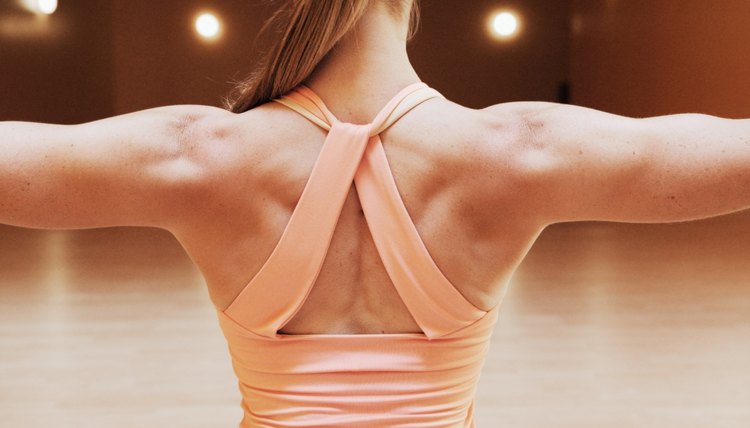How to Exercise Your Traps for Women

The trapezius is a four-headed muscle that extends from the back of the head down to the middle back region. The upper region, called the upper traps, comprises two heads. The uppermost of these heads extends the neck, while the lowermost elevates the shoulder. The middle and lower regions of the muscle group, called the middle and lower traps, respectively, function to retract the shoulder blades, thus moving them in the rear direction. Women can improve the shape of their rear neck and middle-to-upper back regions by exercising their trapezius muscles.
Standing Dumbbell Side Shrug
Grasp a dumbbell with each hand in an overhanded grip.
Stand upright with your arms straightened and dumbbells held by your sides.
Elevate your shoulders in a shrugging motion, trying to touch your shoulders to your ears.
Lower your shoulders down to the initial point.
Repeat the movement until you reach the target repetition count. You can also do this exercise unilaterally, or a single side at a time, by only elevating one shoulder at a time. This can help you better concentrate on the motion.
Bent-Over Underhand Barbell Row
Hold a barbell with each hand in an underhanded grip.
Lean your torso forward until it is about parallel to the ground. Bend your knees a bit to lessen the stretch on your hamstrings.
Position the barbell parallel to your torso with your arms straightened.
Raise the barbell up to your lower stomach by bending your elbows and retracting your shoulder blades.
Return the barbell downward by extending your elbows and moving your shoulder blades forward. Repeat the movement until you reach the target repetition count.
Tips
To best develop the musculature of your trapezius muscles, use the heaviest amount of weight possible that allows you to complete 10 to 12 repetitions with the strictest form possible. Never sacrifice the proper form for heavier weights to minimize injury. Do three to five sets for each trapezius exercise in your workout routine.
Warnings
Be careful not to round your back while executing the bent-over barbell underhand row, as that puts your spine in a vulnerable position, thus increasing your risk of spinal injury. Also, avoid excessive hyperextension of your back, as that can also result in spinal injury. It is best that you maintain a flat back position for minimizing injury risks.
References
Writer Bio
Richard Choueiri is a fitness and nutrition expert and the author of "The Human Statue Workout." He began writing professionally in 2007 and his work has been featured in Bodybuilding.com and "Physique Magazine." Choueiri studied exercise science and nutritional science at Rutgers University. He holds an American College of Sports Medicine CPT, and a National Exercise and Sports Trainers Association CMMACC.
